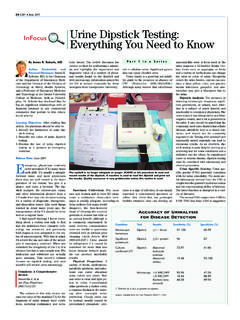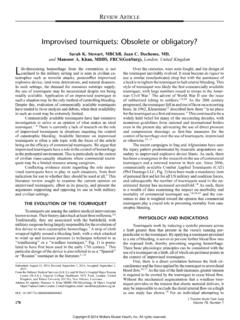Transcription of Don't pack abscesses, ever! - Keith Conover's Home …
1 Don't pack abscesses , ever! I figured this title would illicit some input from my colleagues. As I reviewed the medical literature, regarding the use of packing wounds (12 studies in total, 3 that were of any use), it was difficult to find a true consensus. I recognize that this dogmatic practice has been around for a number of years. In fact, I was not only taught the practice of packing wounds in my medical school years but shared such practice with residents whom I have supervised. However, the question we must ask ourselves is a simple one. Is the practice of packing wounds still a valid practice today? The short answer is an emphatic no!
2 Packing of wounds was first suggested in the surgical literature as early as the 1950's. Dr. John Lister was the first to use phenol (carbolic acid) soaked dressings on surgical wounds. The end result was a significant decrease in infection and mortality among his patients. Robert Johnson (of Johnson and Johnson) is credited with the development of iodine soaked dressings and the formal packing of wounds. Clearly the observations of Louis Pastuer ( the father of microbiology ) had not gone unnoticed. These early Physicians identified the need of an antimicrobial agent to improve tissue healing. I suspect that it was this philosophy which has perpetuated the current practice of wound packing.
3 Yet was it the packing that improved these outcomes or the antimicrobial effects of placing a germ toxic ointment on the wounds? Most would believe that packing wounds keeps the wound open for drainage which expedites healing time. However, those observations have not been proven through clinical observational studies. It is certainly true that packing a wound keeps the wound open longer. You do not need to be a Mensa candidate to appreciate the fact that sticking a foreign body in an opening will prevent the closure of the opening (unless of course you're a Hans Brinker fan ( finger in the dike story ?). Stewart et al reviewed 137 surgical abscess cases.)
4 Sixty-four had I&D with surgical closure only, and seventy-three had an I&D with packing. The mean healing time in the group without packing was seven days, while the mean healing time for the packed group was 25. days. Not only were healing times prolonged but loss days from work were 4 days as compared with the packing group with 14 lost days[1].This study was not perfect but it did strongly suggest that contrary to popular belief packing wounds actually delays healing and increases lost days of work. Similar observations were noted by Barnes in 1988 and Abrahams in 1997. In fact I found no studies to suggest that packing a wound enhances healing time.
5 To the contrary, Tonkin et al. noted improved healing, and reduction of pain in a group of 23 patients who underwent perianal abscess I&D without packing as compared to 20 patients who received packing for their wounds[2]. I can hear the voices in my head telling me I am all wrong about why we pack wounds. After all, we pack wounds not to enhance healing but to keep the wound from closing prematurely, and allow the drainage of materials (evil humors) from the wound site, right? The truth seems to contradict this premise in a review of the literature by Barnes et al[3] who observed recurrence rates of infection were greater among those with packing versus those without packing.
6 How can this be? The eMedicine chapter on perirectal abscess seems to identify the reason (which I underlined for emphasis): "Do not pack the abscess full of iodoform gauze. The intent is to keep the surgical incision open so that pus and other material can drain. If iodoform gauze stripping is used, using a limited amount of gauze is important, that is, just enough to keep the wound open. Packing the wound full of iodoform gauze does not improve the outcome, and, in fact, it may worsen the prognosis by creating a large foreign body that may become a nidus of infection. ". Please note the bold print above for effect. The very fact that we ask patients and their family members to pack wounds could be the greatest opportunity for a malpractice case among our clients.
7 I can hear the voices in the court room; well your honor, I never thought that by having a non-medical person insert a non-sterile bacterial wicking cloth into a fresh wound would become the nidus of infection.. More than half a century (57 years to be exact), has passed and we continue the practice of packing wounds. We seem to go to great lengths to teach patients and their family members on how to pack their own wounds (albeit via non-sterile techniques). We might as well ask our patients to put Honey on their wounds; at least this has some efficacy [4]. The reviewed of the literature on the care and feeding of abscesses certainly appears to remove any justification for the traditional method of packing abscess cavities.
8 Wicking occurs when a piece of cord that conveys liquid by capillary action is placed on or into a wound site; "the physician put a wick in the wound to drain it". The terminology is a bit semantic. However, I prefer to place an absorbent material (gauze dressing) on the wound. This in turn provides the "wicking action" you are referring to without prolonging the healing process. If you stick anything into a cavity you are technically packing it (or making sausage). Show of hands; How many of you are culturing the wounds, giving antibiotics, or making bratwurst? Education's purpose is to replace an empty mind with an open one. Malcolm Forbes No room for you fence huggers Dr.
9 C. [1] Stewart MP. Laing MR. Krukowski ZH. Treatment of acute abscesses by incision, curettage and primary suture without antibiotics: a controlled clinical trial. British Journal of Surgery. 72(1):66-7, 1985 Jan. [2] Tonkin DM, Murphy E, Brooke-Smith M, Hollington P, Rieger N, Hockley S, Richardson N, Wattchow DA. Perianal abscess: a pilot study comparing packing with nonpacking of the abscess cavity. Dis Colon Rectum. 2004. Sep;47(9):1510-4. Epub 2004 Jul 8. [3] Barnes SM. Milsom PL. abscesses : an open and shut case. Archives of Emergency Medicine. 5(4):200-5, 1988. Dec. 4 Okeniyi JA, Olubanjo OO, Ogunlesi TA, Oyelami of healing of incised abscess wounds with honey and EUSOL dressing.
10 J Altern Complement Med. 2005 Jun;11(3):511-3. Additional References Simms MH. Curran F. Johnson RA. Oates J. Givel JC. Chabloz R. ALexander-Williams J. Treatment of acute abscesses in the casualty department. British Medical Journal Clinical Research Ed. 284(6332):1827-9, 1982 Jun 19. Sorensen C. Hjortrup A. Moesgaard F. Lykkegaard-Nielsen M. Linear incision and curettage vs. deroofing and drainage in subcutaneous abscess. A randomized clinical trial. Acta Chirurgica Scandinavica. 153(11-12):659-60, 1987 Nov-Dec.


